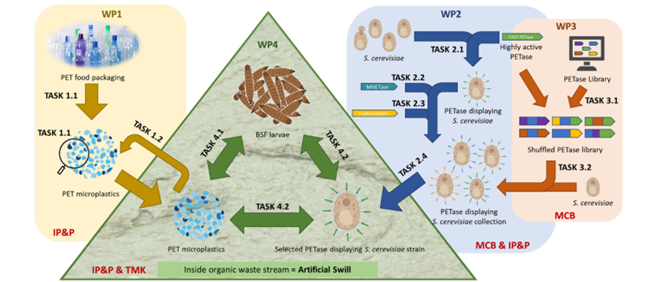PETyFLY
Valorisation of PET-contaminated side streams
Yeast cell surface display of PET-hydrolyzing enzymes to degrade PET and pretreat PET-containing organic side streams prior to black soldier fly larvae rearing
Project objective
Worldwide, polyethylene terephthalate (PET) is one of the most frequently used synthetic polyesters, being applied as packaging material. Given their frequent use, combined with the lack and/or failure of recycling programs, these plastics and their fragmented variants, i.e., micro, and meso plastics, are ubiquitously present in organic side streams. For example, PET plastics have been found in residual valuable biomass derived from the food industry, supermarkets, and restaurants. Should this biomass be used as feed for rearing insects, these PET particles may affect insect growth and bioconversion or accumulate in the insect biomass. At the same time, these plastics might end up in the insect residue also referred to as frass, which hinders its use as an organic fertilizer. To valorize these contaminated valuable biomass streams, this project aims to display PET hydrolases on the cell surface of yeast to degrade PET. The ability of these constructed strains to break down residual PET and thus serve as a pretreatment method for such biomass contaminated with PET, prior to black soldier fly rearing, will be assessed. If successful, this will create a more valuable use of such waste streams, closing an open loop in our food chain.
Project approach
To achieve the objectives, a total of four work packages are planned of which two start in parallel. WP1 will focus on the generation, characterization, and separation methods of the post-consumer PET microplastics. This will provide a baseline to which the impact of yeast-(and/or BSF larvae-) derived PET degradation further on in the project can be determined. The data generated in WP1 will also shed light on the characteristics (crystallinity, molar mass, polymer structure) of self-generated post-consumer PET microplastics. In the parallel work package (WP2), molecular engineering of S. cerevisiae will be performed to construct a S. cerevisiae whole-cell catalyst with high PET degradation activity. This will yield invaluable information on the ideal layout of these constructs to achieve optimal PETase activity of the FAST-PETase enzyme. However, even better enzymes might exist, and in WP3, a protein database search for orthologs combined with a gene shuffling approach and high-throughput selection will be used to expand the repertoire of PET hydrolyzing enzymes even further. Finally, after the selection of the most potent S. cerevisiae isolate in the actual artificial organic waste stream (=swill) (Task 2.4), the effect of the best whole-cell catalyst on the BSF larval performance and PET microplastics contamination will be explored in WP4.

This project is a collaboration between



